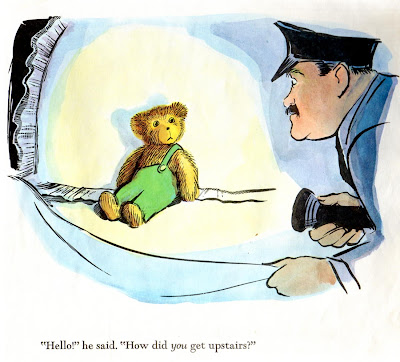Well, I'm back from the 2008 Small Press Expo. I arrived a little late due to I-95 getting shut down because of an accident. Then I got totally overwhelmed by the amount of amazing-looking stuff available; I could have spent several days and several thousand dollars without seeing everything worthwhile.
But I got it together enough to buy some stuff, and I said hi to a bunch of folks that have been nice enough to send me review copies, including Eric Reynolds at
Fantagraphics, Cory Casoni at
Oni Press, and Chris Staros at
Top Shelf. (Anyone know why First Second was not at the Expo? They seemed like the only publisher that should have been there but was not.) I also introduced myself to a bunch of artists and writers, including
Becky Cloonan, who seemed to remember that I had reviewed her book
Pixu #1, so that was neat.
And I got to see the Critics Roundtable, which was sort of interesting and sort of too short to really go into depth on anything.
Jog comes off as just as smart in person as he does in his writing, and seemed to be a good listener. He also interviewed
Bryan Lee O'Malley, creator of
Scott Pilgrim, and seemed to know more about O'Malley's history and influences that O'Malley did. But the interview was fun, and it was interesting to see the amount of fan love for that comic on display in the room -- people really do like it.
(edited to add:) And I do too!
But man, did I mention the amount of awesome comic book goodness? Fantagraphics, Top Shelf, Drawn & Quarterly, Oni, AdHouse, Picturebox, Fanfare/Ponent Mon, Buenaventura: all had tables packed with what seemed like their entire back catalogs. And there were tons of other publishers and people with their self-published comics. I really wanted to get
Skim, which ended up winning the Ignatz award for Best Graphic Novel, but I held off. And the only thing that I wanted but couldn't get because it sold out (I saw it, but when I went back it had disappeared) was Gerald Jablonski's
Cryptic Wit #2.
So here is what I got:5, by Becky Cloonan, Fabio Moon, Gabriel Ba, Rafael Grampa, & Vasilis Lolos (self-published). This is a mini-comic published in 2007. I loved
Pixu, so I was happy to grab this.
Crogan's Vengeance, by Chris Schweizer (Oni Press). I love pirates, and historical fiction, and this book about a pirate is the first in a series of adventure graphic novels following the history of various members of the Crogan family. So count me in. Plus, it seemed like something that my kids would like when they got a little older. The author Chris Schweizer was very friendly and drew a great little picture in there for them.
Escalator, by Brandon Graham (Alternative Comics). This is an older work, but I really can't get enough of Graham's stuff. If you haven't read
King City or
Multiple Warheads yet, go get them IMMEDIATELY.
Ganges #1 & 2, by Kevin Huizenga (Fantagraphics). I've been thinking about getting these for a while, so now here they are.
How to Understand Israel in 60 Days or Less, Chapters 1 & 2, by Sarah Glidden (self-published). This was nominated for an Ignatz Award, and
it looks like the book has been picked up by Vertigo.
Otto's Orange Day, by Frank Cammuso & Jay Lynch (Toon Books). This was published by the new kid's comics company run by Francoise Mouly and her husband, Art Spiegelman. I already have the company's newer stuff, so I got this. And Frank Cammuso drew a picture in it for my kids, which is cool.
Superf*ckers #1, by James Kochalka (Top Shelf). I dug his kid's comic
Johnny Boo, and he was very friendly. I also got
Rainbow Frog, a comic made by his five-year-old son (promising work; good use of negative space, har har). When I went to buy this he was talking with Heidi MacDonald from The Beat about being famous, or something like that.
So that's my story from SPX. I had a good time, and hopefully I'll head back again next year.
 The new publisher TOON Books, created by New Yorker art editor Françoise Mouly and her husband Art Spiegelman, has released a number of children's comics that are worthy of a place on your kid's bookshelf. Here is the first of three reviews of their newest books.
The new publisher TOON Books, created by New Yorker art editor Françoise Mouly and her husband Art Spiegelman, has released a number of children's comics that are worthy of a place on your kid's bookshelf. Here is the first of three reviews of their newest books.

















































